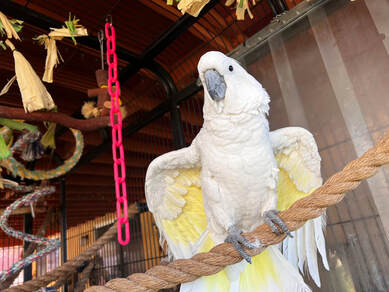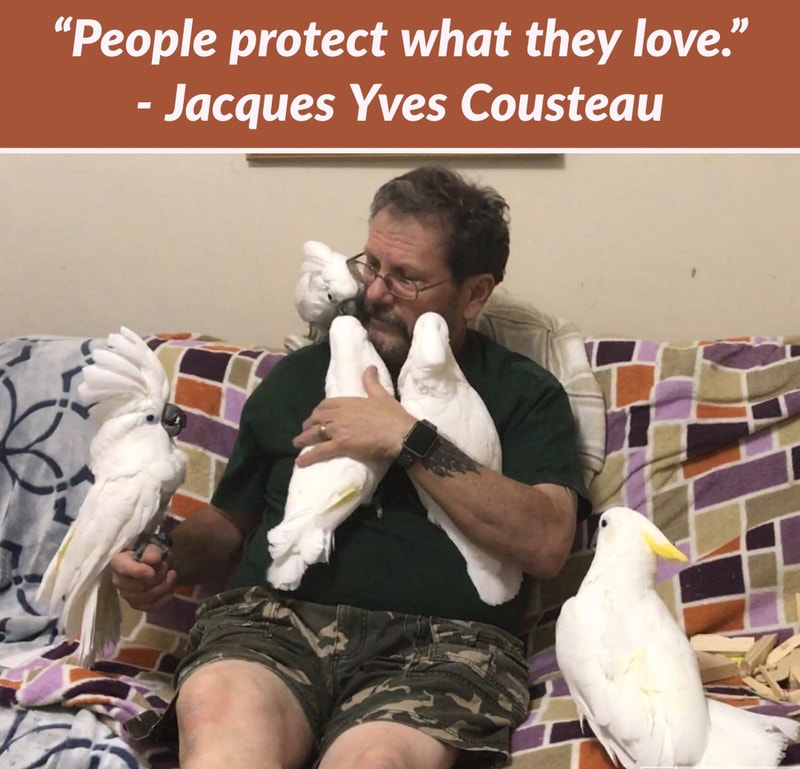
A true story of a couple’s quick thinking that saved the eyesight of their birds.
Any knowledgeable bird person is aware of that their birds require UVA and you UVB. The best form of this lighting comes from the star nearest the earth, the sun. Getting your birds in a sun for at least 15 minutes a day is the best way to ensure that your birds get the light that they need. There are other alternatives. Special lighting designed for birds helps to provide the necessary ultraviolet they require. Still, there are dangers. There are also special things that you should know.
I recently spoke with a couple who had a bird with an eye problem. The eye on one side of the head had closed and a discharge was noticeable. They took their bird to immediately to the nearest avian vet. They live out of a large recreational vehicle and were not in the town where their primary veterinary is located. The avian vet was unable to determine the problem with the eye. They returned home and began searching the Internet for information. They discovered the problem using logic based on what happened in the next few days.
They moved the bird to a different location within the home and other birds took her spot. The eye problem of the first bird quickly vanished. Yet both of the birds who had been moved to the first bird’s spot developed a similar problem, one on the right side of its face and the other on the left side of its face. It dawned on them that eight ultraviolet light was shining into the eyes of the suffering birds and that the eye facing the light was the one affected. They removed the light and the problem went away.
Pure research they discovered that ultraviolet lamps are designed for reptiles produce far too much ultraviolet light. This damages the cornea. Fortunately, unless they are exposed to this white for a long period of time, such as a few weeks, the cornea repairs itself.
They had purchased the lights because they were out of town and needed to replace the lights that they had in their RV. No avian bulbs were available at the time and they took what they could get locally.
The avian vet which they had visited apparently was unaware of such an issue and simply offered a salve to ease the irritation. This is a common problem with veterinary science. Quite often they do not look into the environment of the bird; it is almost assumed that every problem is organic. This couple understood that they have a responsibility to do research on their own. Professionals are here to help but ultimately it is our responsibility to care for the health of our companions.
All the birds that were affected by the intense ultraviolet light are now healthy. There is no residual problem. The most difficult thing to do in these situations is to observe and think clearly. This couple did a wonderful job of thinking on their feet and protecting those in their care.
Another problem with ultraviolet lighting is a short distance it travels. When you install such a light –a proper avian light –keep in mind that generally the distance that the light travels is less than 2 feet. Check the specifications on the bulb. Also remember that these bulbs have a short life span and they need to be changed regularly. Be sure to note the date they need to be changed on your calendar. You may have to do some calculations to be sure the bulb still has potency. They often will give you a lifespan for the bulb based on a number of hours per day. If the light burns longer than that then you will need to adjust the lifespan accordingly.
The couple commented to me that they wanted to harness their flighted birds and were encouraged to learn about the Aviator harness. Knowing them, I am sure that their birds will get plenty of sunlight.
Any knowledgeable bird person is aware of that their birds require UVA and you UVB. The best form of this lighting comes from the star nearest the earth, the sun. Getting your birds in a sun for at least 15 minutes a day is the best way to ensure that your birds get the light that they need. There are other alternatives. Special lighting designed for birds helps to provide the necessary ultraviolet they require. Still, there are dangers. There are also special things that you should know.
I recently spoke with a couple who had a bird with an eye problem. The eye on one side of the head had closed and a discharge was noticeable. They took their bird to immediately to the nearest avian vet. They live out of a large recreational vehicle and were not in the town where their primary veterinary is located. The avian vet was unable to determine the problem with the eye. They returned home and began searching the Internet for information. They discovered the problem using logic based on what happened in the next few days.
They moved the bird to a different location within the home and other birds took her spot. The eye problem of the first bird quickly vanished. Yet both of the birds who had been moved to the first bird’s spot developed a similar problem, one on the right side of its face and the other on the left side of its face. It dawned on them that eight ultraviolet light was shining into the eyes of the suffering birds and that the eye facing the light was the one affected. They removed the light and the problem went away.
Pure research they discovered that ultraviolet lamps are designed for reptiles produce far too much ultraviolet light. This damages the cornea. Fortunately, unless they are exposed to this white for a long period of time, such as a few weeks, the cornea repairs itself.
They had purchased the lights because they were out of town and needed to replace the lights that they had in their RV. No avian bulbs were available at the time and they took what they could get locally.
The avian vet which they had visited apparently was unaware of such an issue and simply offered a salve to ease the irritation. This is a common problem with veterinary science. Quite often they do not look into the environment of the bird; it is almost assumed that every problem is organic. This couple understood that they have a responsibility to do research on their own. Professionals are here to help but ultimately it is our responsibility to care for the health of our companions.
All the birds that were affected by the intense ultraviolet light are now healthy. There is no residual problem. The most difficult thing to do in these situations is to observe and think clearly. This couple did a wonderful job of thinking on their feet and protecting those in their care.
Another problem with ultraviolet lighting is a short distance it travels. When you install such a light –a proper avian light –keep in mind that generally the distance that the light travels is less than 2 feet. Check the specifications on the bulb. Also remember that these bulbs have a short life span and they need to be changed regularly. Be sure to note the date they need to be changed on your calendar. You may have to do some calculations to be sure the bulb still has potency. They often will give you a lifespan for the bulb based on a number of hours per day. If the light burns longer than that then you will need to adjust the lifespan accordingly.
The couple commented to me that they wanted to harness their flighted birds and were encouraged to learn about the Aviator harness. Knowing them, I am sure that their birds will get plenty of sunlight.
















